Have you ever experienced this?
Walking outside, as you’re walking you realize your Thumb hurts a lot. You rush home and quickly take off your shoes to find that the toenail of your Thumb has grown into the flesh.
This…
Should the toenail that has grown into the flesh be pulled out and cut off?
Should it be “disinfected” after being cut?
What if it still hurts a few days after being cut?
Don’t worry, I’ll guide you on how to avoid ingrown toenail.
First, if your toenail has grown into the flesh, it’s likely you have an ingrown toenail
Ingrown toenails refer to when the edges or corners of the fingernails or toenails are embedded in the skin. Typically, the Thumb is more prone to ingrown nails than other fingers or toes.
When an ingrown toenail occurs, there is usually a feeling of swelling and pain. If an infection occurs, it can lead to paronychia.

Second, how should an ingrown toenail be dealt with?
Generally, when you notice that your toe is uncomfortable and realize that you might have an ingrown toenail, it is still in the inflammation phase or a mild abscess period.
The signs of the inflammation phase: there are red spots, mild edema, and the feeling of pain when pressed, the nail fold (the ‘flesh’ into which the toenail is embedded) has not surpassed the nail plate;
Signs of the mild abscess period: red spots, edema, more severe pain, pus seeping out, and the height of the nail fold surpasses the nail plate (the excess height is ≤ 3 mm).
At this point, you can use conservative treatments to solve the problem.
For ingrown nails without pus, you can soak your feet in warm water to relieve symptoms:
Soak your feet in 45°C warm water for 10-20 minutes to soften the toenails. Soak once a day until the symptoms ease.
After softening your toenails, You can use nail clippers to carefully cut off excess nails.
If the swelling is quite noticeable, you can apply a little iodine or antibiotic ointment to the swollen area (such as fusidic acid ointment or mupirocin ointment).
For ingrown nails with pus, you can use dental floss to let the pus flow out, and after the pus flows out, use the above-mentioned warm water soaking method to relieve symptoms and cut off the excess toenails:
Take a piece of waxed dental floss and slowly tilt it into the place where the nail has grown in. Gently lift it to separate the toenail from the nail fold.
Doing this can reduce the pressure of the toenail on the nail fold, and can also help the pus flow out. Do this every day with a new piece of dental floss until the symptoms ease.

There are also methods of stuffing cotton balls, but they are more difficult to operate. If the two methods introduced above cannot relieve discomfort, it is recommended to go to the hospital and see a dermatologist.
In addition to the inflammation period and mild abscess period, ingrown toenails can also have more severe conditions such as a serious abscess period, hyperplasia period, distal hyperplasia period, etc. At this time, doctors may need to use minor surgical methods to treat them.
Therefore, it is suggested that once you notice an ingrown toenail, you should deal with it correctly as soon as possible. Don’t delay, and don’t cut it randomly.
Third, why can toenails grow into the flesh?
The causes of ingrown toenails can be innate or acquired.
Innate factors include abnormal angles of the inter-digital joint, congenital nail misalignment, and excessively wide congenital nail surface.
More often, it is caused by acquired factors:
- Over-trimming of the nail edge or cutting the toenails too short. The surrounding soft tissue, without the cover of the nail, grows upwards. As a result, when the nail grows out, it falls into the soft tissue;
- Regularly wearing inappropriate shoes;
- Traumatic nail damage;
- Excessive sweating of the feet or edema of soft tissues;
- Nail trauma or fungal infection. Bacteria and fungi on the surface of the skin enter the open wound, leading to an ingrown toenail ~ paronychia;
- Deformities of the nail or foot, biomechanical imbalances such as hallux valgus, pressure on the toes caused by movement, wearing elastic socks, etc;
- Skin diseases involving nails, such as fungal nail disease, psoriasis, flat lichen, etc. This can cause the epithelial shift from the nail bed to nail matrix to be interrupted, and the normal anatomical continuity between the nail bed and nail groove changes and deforms;
- Taking retinoic acid, immunosuppressants or chemotherapy drugs.
- Correctly trimming toenails, choosing suitable shoes, actively treating primary nail diseases, avoiding secondary infections, wearing loose and breathable shoes and socks… Doing these things can prevent ingrown nails to a large extent.
Correct methods for trimming your nails:
Avoid cutting too short, leave at least 1 mm of the white part at the front; avoid cutting the nails vertically, the edges of the nails should be trimmed to be close to square rather than round or even “V” shaped.

0